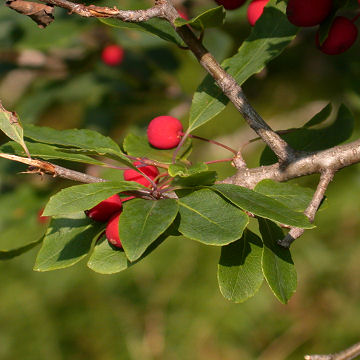

Nemopanthus mucronatus - (image 1 of 5)
Taxonomy
Family: Aquifoliaceae
Habitat
Bogs, swamps, other moist or wet places. Typical associates indicate a preference for acidic conditions.
Associates
Distribution
New England west to MN, south WV to IN.
Morphology
Dioecious, branching shrub. Leaves elliptic, rounded to acute and sharp-pointed (mucronate), entire to finely serrate. Flowers (4)5-merous, axillary, on long pedicels to 3 cm long; petals narrow, yellowish, to 2 mm; anthers free; sepals obsolete. Fruit red to yellowish containing dorsally smooth or ribbed nutlets.
Notes
Flowers Marsh to June
Wetland indicator: Obligate
There are several plants called "mountain holly", and this one is sometimes called false holly, although it is in the holly family. Recent molecular investigation suggests this species belongs in the genus Ilex, and it has therefore been renamed Ilex mucronata (L.) M. Powell et al.
These plants were photographed in the Adirondacks near Cranberry Lake.
Bibliography
Gleason, Henry A. and A. Cronquist. 1991. Manual of Vascular Plants of
Northeastern United States and Adjacent Canada. Second Ed.
The New York Botanical Garden. Bronx, NY
Powell, M., V. Savolainen, P. Cunoud, J.-F. Manen and S. Andrews. 2000. The mountain holly (Nemopanthus mucronatus: Aquifoliaceae) revisited with molecular data.
Kew Bull. 55:341–347.
Swink, F. and G.
Wilhelm. 1994. Plants of the Chicago Region.
Indiana Academy of Science. The Morton Arboretum. Lisle, Illinois.
USDA, NRCS. 2002. The PLANTS Database, Version 3.5 (http://plants.usda.gov).
National Plant Data Center, Baton Rouge, LA 70874-4490 USA.
|
Michael Hough © 2009 |